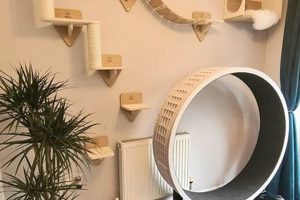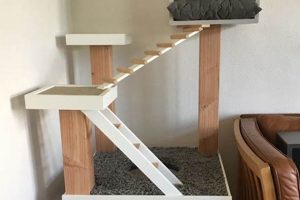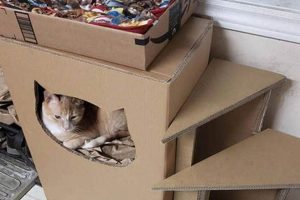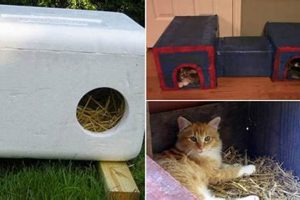A structure designed to allow domestic felines to engage in vertical exploration and exercise within an indoor environment, often constructed from readily available materials by the owner. An example includes a series of wooden platforms affixed to a wall, providing cats with opportunities to climb, perch, and observe their surroundings from elevated positions.
The provision of such enrichment contributes significantly to feline well-being by addressing their innate climbing instincts and preventing boredom, which can lead to destructive behaviors. Historically, indoor cats have lacked sufficient outlets for their natural physical and mental energy, making the integration of vertical space a crucial aspect of responsible pet ownership.
Considerations for constructing an elevated feline environment include structural integrity, material safety, and the overall design’s integration with the home’s aesthetics. Subsequent sections will delve into specific materials, construction techniques, and design considerations to ensure a safe and stimulating environment for the feline companion.
DIY Cat Climbing Wall
The construction of vertical feline enrichment requires careful planning and execution to ensure the safety and well-being of the animal. These tips outline key considerations for a successful project.
Tip 1: Material Selection: Employ solid wood or plywood for platforms. Avoid particleboard due to its low structural integrity and susceptibility to moisture damage. Ensure all wood is sanded smooth to prevent splinters.
Tip 2: Secure Mounting: Utilize appropriate wall anchors based on wall type (drywall, plaster, stud). Weight capacity of anchors must exceed the combined weight of the cat and any potential additional weight (e.g., other cats climbing simultaneously). Consult a hardware professional if uncertain.
Tip 3: Platform Size and Spacing: Platforms should be sufficiently large to accommodate the cat’s full body length. Spacing between platforms should be challenging but manageable for the cat, encouraging exercise without posing an injury risk. Typically, 12-18 inches vertically is a good range.
Tip 4: Incorporate Scratching Surfaces: Integrate sisal rope or carpet scraps onto platforms and vertical posts. This encourages natural scratching behavior, diverting it away from furniture. Secure these materials firmly to the wood substrate with staples and non-toxic adhesive.
Tip 5: Consider Cat’s Physical Abilities: Account for the cat’s age and physical condition. Elderly or arthritic cats may require lower platform heights and ramps for accessibility. Observe the cat’s climbing ability and adjust the design accordingly.
Tip 6: Stability Testing: Prior to allowing the cat access, thoroughly test the structure for stability. Apply significant pressure to each platform and connection point. Reinforce any areas exhibiting weakness.
Tip 7: Regular Inspection and Maintenance: Conduct routine inspections to identify loose hardware, frayed rope, or damaged wood. Promptly repair or replace any compromised components to maintain structural integrity and prevent injuries.
The implementation of these guidelines contributes to a safe and stimulating environment for the feline, promoting physical activity and mental well-being. Regular maintenance is crucial to long-term safety and enjoyment.
The following section will address design aesthetics and integration within various home environments.
1. Structural Integrity
Structural integrity is paramount in the construction of a vertical feline environment. The failure to adequately address structural stability poses a direct threat to the safety and well-being of the animal. The essential connection lies in the fact that a collapse or failure of the structure can result in serious injury, ranging from minor scrapes and bruises to bone fractures or, in extreme cases, fatal trauma. For example, inadequately secured platforms can detach from the wall, causing the cat to fall from a significant height.
The selection of appropriate materials and the implementation of robust fastening techniques are crucial elements in ensuring structural integrity. Solid wood, such as pine or oak, provides a more reliable foundation than particleboard, which is prone to crumbling under stress. Furthermore, the use of wall anchors rated for a weight exceeding the combined weight of the cat and the structure itself is essential. The spacing of support studs within the wall must also be considered, ensuring that mounting points are adequately reinforced. A real-world example illustrates the importance of this: a climbing wall constructed with insufficient wall anchors failed to support the weight of a cat, resulting in the detachment of a platform and subsequent injury to the animal.
In conclusion, structural integrity represents a non-negotiable aspect of vertical feline construction. Compromising on material quality or fastening security introduces a significant risk of harm to the animal. Continuous maintenance and inspection is crucial. Therefore, thorough planning, careful execution, and ongoing monitoring are required to ensure a safe and enriching environment.
2. Material Safety
Material safety is a critical component in the design and construction of structures for domestic animals, particularly in the context of vertical climbing apparatus. The selection of inappropriate materials presents a direct threat to the animal’s health and well-being. This consideration extends beyond obvious hazards such as sharp edges or splinters to encompass potential chemical exposure and ingestion of non-digestible substances. For instance, the use of treated lumber intended for outdoor use introduces the risk of toxic exposure through direct contact or ingestion of wood fragments. Similarly, certain paints, adhesives, and fabrics contain volatile organic compounds (VOCs) or toxic dyes that can cause respiratory irritation or allergic reactions. A practical example includes the use of carpeting treated with formaldehyde, a known carcinogen, which can off-gas over time, creating a chronic exposure hazard. Ingestion of small parts, such as staples or decorative elements, presents a choking hazard and potential for internal injuries.
The proactive mitigation of these risks requires careful evaluation of all materials employed in the structure’s construction. Solid wood, sourced from reputable suppliers and free of chemical treatments, represents a safer alternative to composite materials. The application of non-toxic, water-based sealants and finishes provides a protective barrier without compromising the animal’s health. The selection of natural fibers, such as sisal rope for scratching posts, minimizes the risk of ingestion of synthetic materials. Regular inspection of the structure is essential to identify and address potential hazards, such as loose fasteners or frayed fabrics. A responsible approach to material selection involves prioritizing animal safety and ensuring that all components meet established safety standards. The use of certified organic cotton, hemp, and wool are also great ideas to ensure safeness for your cats.
In summary, the integration of safety considerations into the planning and execution of vertical feline environments demands meticulous attention to material selection. Failure to prioritize material safety introduces a range of potential health risks. A proactive and informed approach, focused on non-toxic alternatives and ongoing maintenance, is essential to safeguard the animal’s health and ensure a safe and enriching environment. Neglecting any of these steps will result to the harm of your feline, therefore it is something that must be taken with extreme caution.
3. Platform Placement
The strategic arrangement of platforms is a foundational element in the creation of functional and engaging vertical space for domestic felines. Platform placement directly influences the structure’s usability, its capacity for enrichment, and the overall safety for the animal user.
- Accessibility and Usability
Platform placement determines ease of access for cats of varying ages, sizes, and physical abilities. Platforms too far apart or too high may exclude older or less agile cats. The spacing should encourage natural climbing behaviors without posing a fall risk. Consider including ramps or intermediate steps for cats with limited mobility. A successful design facilitates movement for all potential users, regardless of physical limitations.
- Encouragement of Natural Behaviors
Placement should mimic natural climbing opportunities that stimulate instinctive feline behaviors. Varied heights and staggered arrangements encourage exploration, jumping, and perching. Integrating elements that promote scratching, such as sisal-wrapped posts near platforms, further enhances the behavioral enrichment potential. The goal is to create an environment that satisfies innate feline drives.
- Spatial Utilization and Traffic Flow
Platform arrangement impacts the spatial dynamics of the room and the flow of feline traffic. Poorly positioned platforms can obstruct movement or create dead-end spaces. Effective placement integrates the structure seamlessly into the existing environment, providing a clear pathway for the cat to navigate and observe its surroundings. Consider the cat’s preferred routes and vantage points when designing the layout.
- Safety and Fall Prevention
The paramount consideration in platform placement is safety. Platforms must be securely mounted and adequately sized to prevent accidental falls. The distance between platforms should be carefully calculated to minimize jump distances and potential injury. Placement near soft landing surfaces, such as cushioned furniture, can mitigate the risk of harm. Prioritizing safety throughout the design and construction process is crucial.
The aforementioned facets of platform placement underscore its crucial role in creating a successful climbing wall. By carefully considering accessibility, natural behaviors, spatial utilization, and safety, a stimulating and secure elevated environment for the domestic feline can be provided. Iterative assessment and adaptation based on the individual cat’s needs and preferences is essential for optimizing the final design.
4. Scratching Integration
The incorporation of designated scratching surfaces within a constructed vertical feline environment addresses a fundamental behavioral need and contributes significantly to both the physical and psychological well-being of the animal. Strategic integration mitigates destructive scratching of household furnishings while providing a healthy outlet for natural instincts.
- Redirecting Undesirable Behavior
The primary function of integrated scratching surfaces is to divert scratching behavior away from furniture, carpets, and other household items. By providing more appealing and accessible alternatives, the likelihood of damage to valued possessions is reduced. For example, affixing sisal rope to a vertical post adjacent to a platform offers a readily available and texturally satisfying scratching option, thereby minimizing the cat’s inclination to scratch a nearby sofa. This redirection strategy is crucial for maintaining a harmonious living environment.
- Maintaining Claw Health
Scratching serves an essential role in maintaining claw health by removing the outer, dead layers of the claws, preventing them from becoming overgrown or ingrown. The textured surface of a scratching post facilitates this natural shedding process. Integrating various textures, such as sisal, cardboard, or carpet, provides the cat with a range of options, accommodating individual preferences and ensuring effective claw maintenance. The consistent availability of appropriate scratching surfaces is vital for preventing claw-related health issues.
- Marking Territory
Scratching behavior serves as a form of territorial marking, both visually and through the release of scent from glands located in the cat’s paws. Integrating scratching surfaces throughout the vertical environment allows the cat to establish a sense of ownership and security within its territory. Strategically placing scratching posts in prominent locations, such as near sleeping areas or pathways, reinforces the cat’s claim to the space. This territorial marking behavior contributes to the cat’s overall sense of well-being and reduces stress.
- Physical Exercise and Stretching
The act of scratching involves a full-body stretch and engages various muscle groups, promoting physical exercise and flexibility. Integrating vertical scratching posts into the climbing structure encourages the cat to extend its body and strengthen its muscles while scratching. The height of the scratching post should be sufficient to allow for a full extension of the cat’s body. This physical activity contributes to the cat’s overall fitness and prevents stiffness or atrophy.
In conclusion, the purposeful integration of scratching surfaces within a feline vertical environment is essential for addressing behavioral needs, maintaining claw health, facilitating territorial marking, and promoting physical exercise. By providing appealing and readily available scratching options, the structure contributes significantly to the well-being of the domestic feline while protecting household furnishings from damage.
5. Accessibility
Accessibility, within the context of a self-constructed feline climbing structure, directly influences the usability and overall benefit derived by the animal. If the design fails to account for variations in physical capability among individual cats, the structures intended enrichment potential is severely compromised. Cause-and-effect relationships are readily apparent; for example, platforms positioned at excessive vertical intervals prevent geriatric or physically challenged cats from full participation, leading to frustration and potentially fostering negative behaviors. A core function of responsible pet ownership is ensuring environmental enrichment is available to all animals in the household.
Importance lies in creating an inclusive environment, addressing diverse needs. A real-life example involves a multi-cat household with both a young, agile cat and an older cat suffering from arthritis. A climbing wall designed solely for the young cat’s capabilities would be entirely inaccessible to the older cat, creating inequality and potentially contributing to the older cat’s decline in physical activity and mental stimulation. Practical applications include incorporating ramps, staggered platform heights, and providing readily available access points. These elements permit phased introduction and allow cats with varying abilities to gradually acclimate to the structure.
The crucial element is fostering participation across a diverse population. The challenge resides in understanding individual needs. Understanding accessibility in this context permits proactive design adjustments catering to unique requirements. By focusing on accessibility, the construct transcends from a mere climbing apparatus into an inclusive environment that promotes well-being. The practical significance involves positively influencing the quality of life for domestic felines by facilitating full access to environmental enrichment. This understanding, when properly implemented, helps support the fundamental goal of responsible pet ownership by prioritizing the physical and mental well-being of companion animals.
6. Aesthetic Harmony
Aesthetic harmony represents a critical, albeit often overlooked, aspect of integrating a self-constructed feline climbing structure into a domestic environment. The disconnect between a visually appealing home and a poorly designed climbing apparatus can lead to the structure’s underutilization, as the owner may discourage its presence in prominent living spaces. This cause-and-effect relationship highlights the importance of considering design coherence. A climbing wall that clashes with the existing decor is less likely to be viewed as a positive addition to the home, regardless of its functional benefits for the cat. The practical significance resides in the owner’s willingness to accept and maintain the structure, directly impacting the feline’s access to environmental enrichment.
Achieving aesthetic harmony requires careful consideration of several design elements. Color palettes should complement or subtly contrast the existing room decor. Materials, such as wood, fabric, and rope, should be selected to align with the home’s style, whether it is modern, rustic, or traditional. Innovative designs can incorporate shelves, planters, or artwork, seamlessly integrating the climbing structure into the existing decor. For example, a climbing wall constructed from reclaimed wood and adorned with macrame plant hangers can enhance a bohemian-style living room while still providing ample climbing opportunities for the cat. Conversely, a sleek, minimalist design utilizing neutral colors and clean lines can complement a contemporary interior.
In conclusion, aesthetic harmony should not be viewed as a superficial concern but rather as an essential component of a successful feline climbing structure. The seamless integration of the structure into the home environment increases its acceptance by the owner, ensuring the long-term provision of environmental enrichment for the cat. Challenges involve balancing functional needs with aesthetic considerations and adapting designs to individual home styles. Prioritizing aesthetic harmony alongside structural integrity, material safety, and feline accessibility leads to a holistic and beneficial addition to any home shared with a domestic cat.
Frequently Asked Questions
The following questions address common concerns and considerations related to constructing a vertical feline environment. The information provided aims to ensure a safe and enriching experience for both the animal and the owner.
Question 1: What is the minimum recommended height for a climbing structure intended for a domestic feline?
The minimum recommended height is contingent upon the cat’s age and physical abilities; however, a structure incorporating a minimum vertical span of four feet provides adequate climbing and exploration opportunities. Consideration must be given to the cat’s accessibility to the highest points.
Question 2: Are there specific types of wood that should be avoided in the construction of a climbing structure?
Treated lumber, particularly that intended for outdoor use, should be avoided due to potential toxicity. Particleboard, owing to its low structural integrity and susceptibility to moisture damage, is also unsuitable. Solid hardwoods, such as oak or maple, or untreated plywood are preferable.
Question 3: What is the recommended method for securing platforms to a wall, ensuring they can support the weight of a cat?
Platforms should be secured using wall anchors appropriate for the wall type (drywall, plaster, stud). The weight rating of the anchors must exceed the combined weight of the cat and the platform itself. It is imperative to locate wall studs and directly anchor to them whenever possible.
Question 4: What types of materials are suitable for creating scratching surfaces on a climbing structure?
Sisal rope, corrugated cardboard, and carpet remnants are all appropriate materials for creating scratching surfaces. These materials should be securely attached to the structure using staples, tacks, or non-toxic adhesives.
Question 5: How frequently should a climbing structure be inspected for damage or wear?
A thorough inspection should be conducted at least monthly. Pay close attention to the security of mounting hardware, the condition of scratching surfaces, and the overall structural integrity of the unit. Immediate repairs are essential when damage is detected.
Question 6: What measures can be taken to prevent a cat from scratching furniture instead of using the designated scratching surfaces?
Strategic placement of the climbing structure near furniture that the cat frequently scratches is recommended. Additionally, using feline attractants, such as catnip, on the scratching surfaces can encourage their use. Regularly trimming the cat’s nails can also minimize damage caused by scratching.
The key takeaways are the importance of appropriate materials, secure construction, and regular maintenance. A carefully designed and well-maintained climbing structure provides a safe and stimulating environment for the domestic feline.
The following section will summarize the core principles and benefits.
Conclusion
This exploration of the “diy cat climbing wall” has elucidated essential considerations for constructing a safe and enriching vertical environment for domestic felines. Key points encompass structural integrity, material safety, strategic platform placement, integration of scratching surfaces, accessibility for cats of varying abilities, and the maintenance of aesthetic harmony within the home. Addressing these elements promotes both the physical and psychological well-being of the animal.
Responsible pet ownership necessitates a proactive approach to environmental enrichment. The informed application of these principles ensures the creation of a functional and visually pleasing climbing structure, contributing to a more stimulating and fulfilling existence for the feline companion. Prioritizing safety and continuous monitoring of the structure’s condition are paramount to its long-term success and the well-being of the animal.







